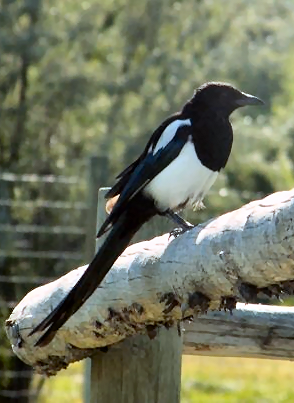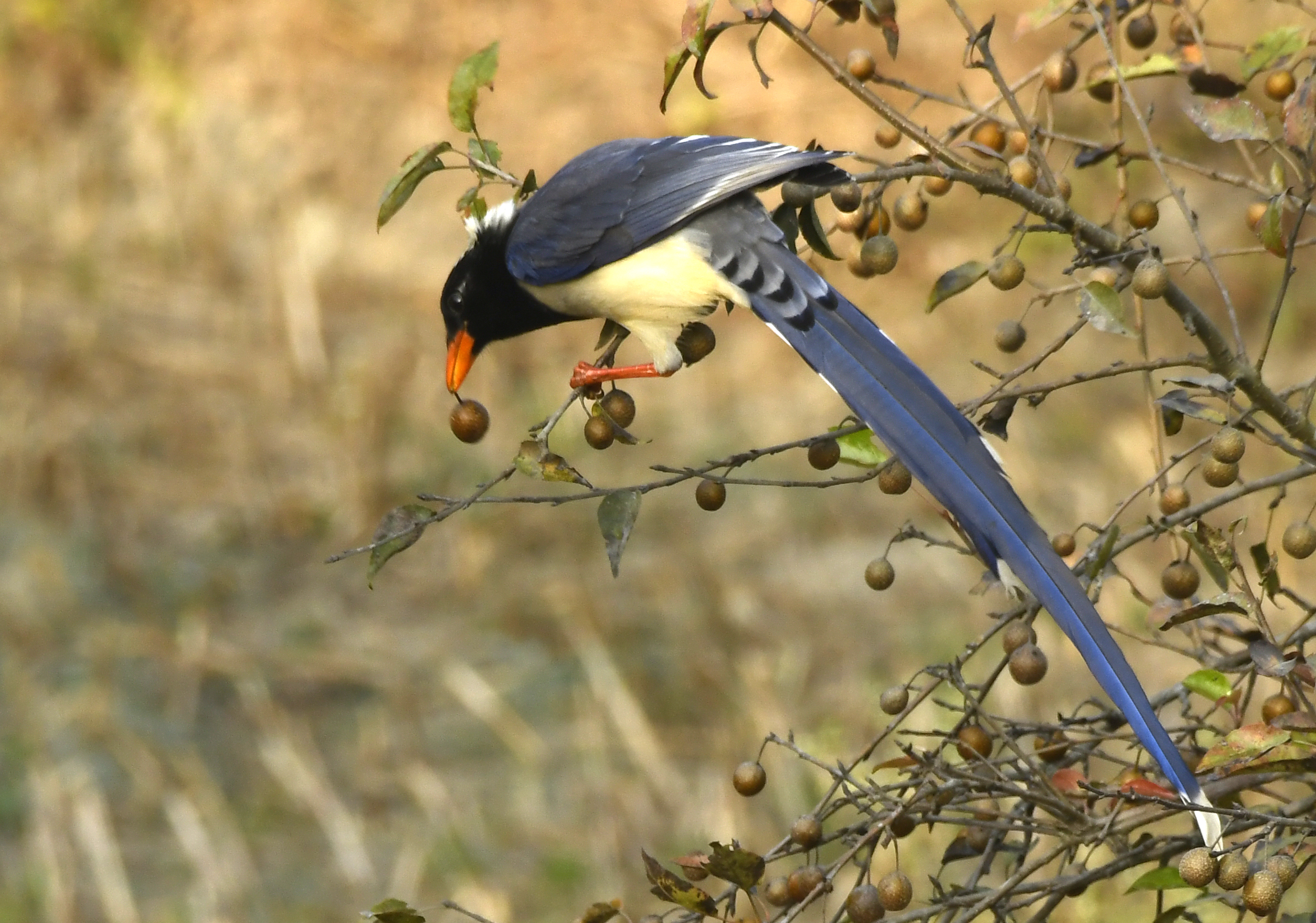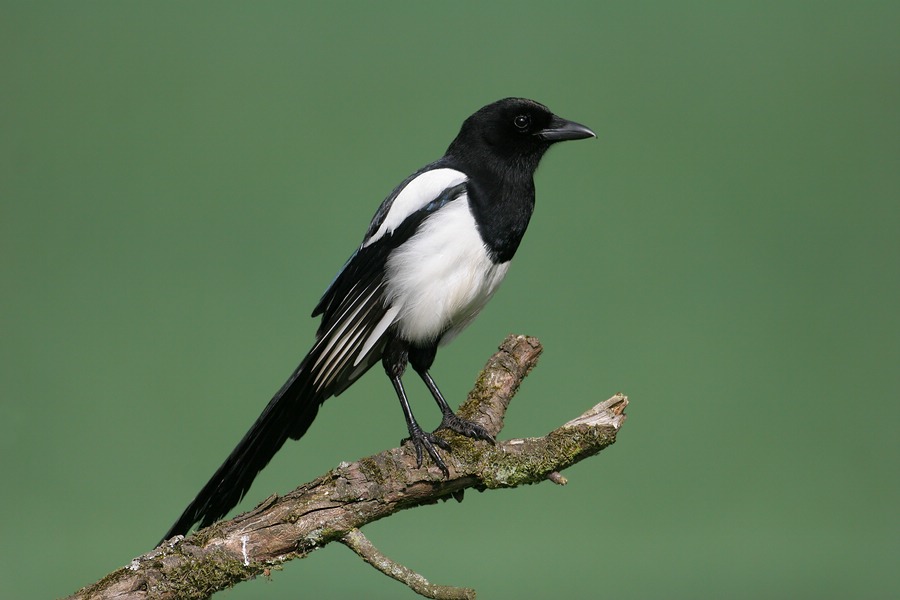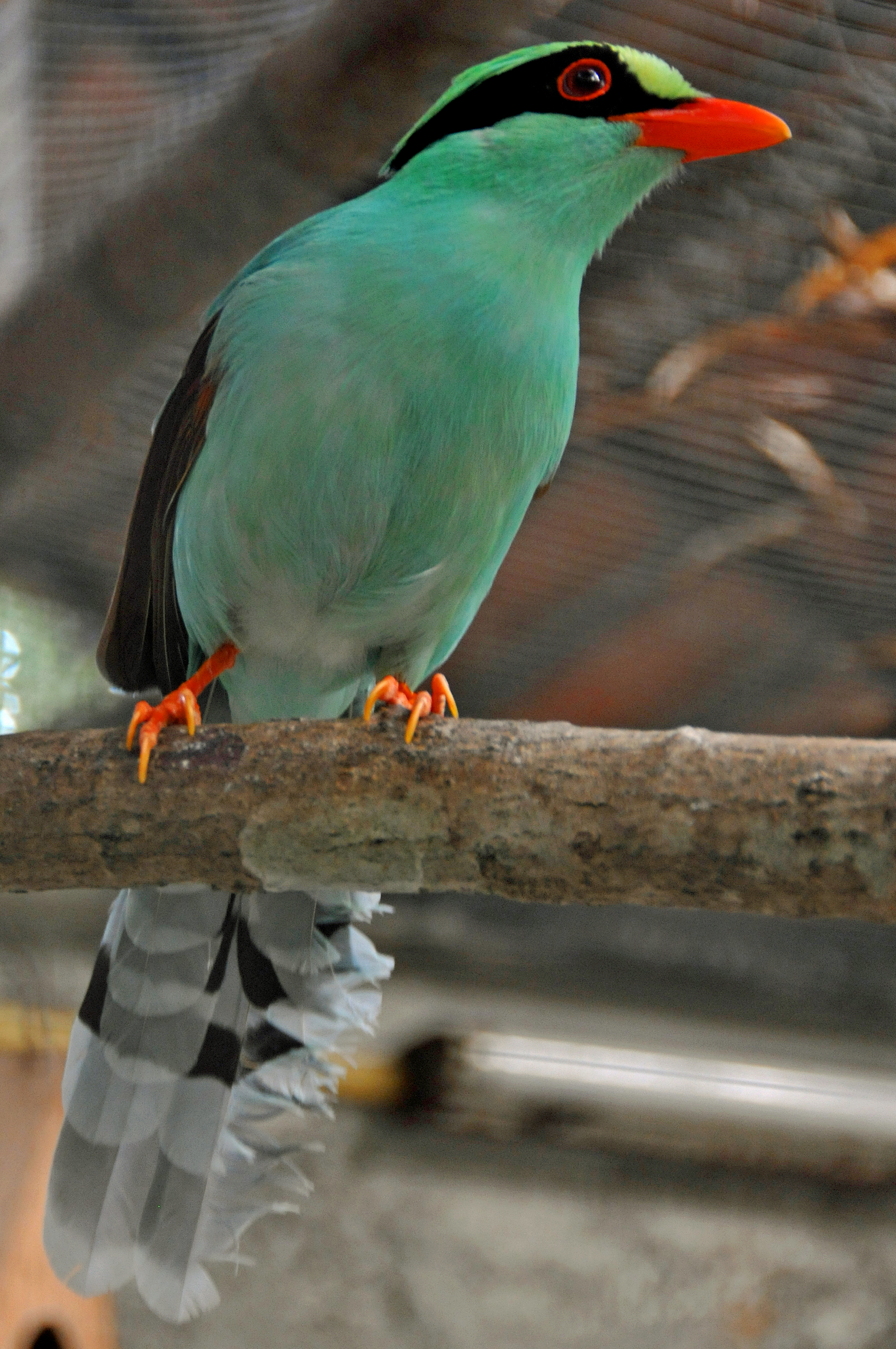|
Magpie
Magpies are birds of the Corvidae family. Like other members of their family, they are widely considered to be intelligent creatures. The Eurasian magpie, for instance, is thought to rank among the world's most intelligent creatures, and is one of the few non-mammal species able to recognize itself in a mirror test. They are particularly well known for their songs and were once popular as cagebirds. In addition to other members of the genus '' Pica'', corvids considered as magpies are in the genera '' Cissa'', ''Urocissa'', and '' Cyanopica''. Magpies of the genus ''Pica'' are generally found in temperate regions of Europe, Asia, and western North America, with populations also present in Tibet and high-elevation areas of Kashmir. Magpies of the genus ''Cyanopica'' are found in East Asia and the Iberian Peninsula. The birds called magpies in Australia are, however, not related to the magpies in the rest of the world. Name References dating back to Old English call the bird a ... [...More Info...] [...Related Items...] OR: [Wikipedia] [Google] [Baidu] |
Australian Magpie
The Australian magpie (''Gymnorhina tibicen'') is a black and white passerine bird native to Australia and southern New Guinea. Although once considered to be three separate species, it is now considered to be one, with nine recognised subspecies. A member of the Artamidae, the Australian magpie is placed in its own genus ''Gymnorhina'' and is most closely related to the black butcherbird (''Melloria quoyi''). It is not closely related to the European magpie, which is a corvid. The adult Australian magpie is a fairly robust bird ranging from in length, with black and white plumage, gold brown eyes and a solid wedge-shaped bluish-white and black bill. The male and female are similar in appearance, but can be distinguished by differences in back markings. The male has pure white feathers on the back of the head and the female has white blending to grey feathers on the back of the head. With its long legs, the Australian magpie walks rather than waddles or hops and spends m ... [...More Info...] [...Related Items...] OR: [Wikipedia] [Google] [Baidu] |
Eurasian Magpie
The Eurasian magpie or common magpie (''Pica pica'') is a resident breeding bird throughout the northern part of the Eurasian continent. It is one of several birds in the crow family (corvids) designated magpies, and belongs to the Holarctic radiation of "monochrome" magpies. In Europe, "magpie" is used by English speakers as a synonym for the Eurasian magpie: the only other magpie in Europe is the Iberian magpie (''Cyanopica cooki''), which is limited to the Iberian Peninsula. The Eurasian magpie is one of the most intelligent birds, and it is believed to be one of the most intelligent of all non-human animals. The expansion of its nidopallium is approximately the same in its relative size as the brain of chimpanzees, gorillas, orangutans and humans. It is the only bird known to pass the mirror test, along with very few other non-avian species. Taxonomy and systematics The magpie was described and illustrated by Swiss naturalist Conrad Gessner in his '' Historiae animal ... [...More Info...] [...Related Items...] OR: [Wikipedia] [Google] [Baidu] |
Black-billed Magpie
The black-billed magpie (''Pica hudsonia''), also known as the American magpie, is a bird in the corvid family found in the western half of North America. It is black and white, with black areas on the wings and tail showing iridescent hints of blue or blue-green. It is one of only four North American songbirds whose tail makes up half or more of the total body length (the others being the yellow-billed magpie, the scissor-tailed flycatcher, and the fork-tailed flycatcher). This species prefers generally open habitats with clumps of trees. It can therefore be found in farmlands and suburban areas, where it comes into regular contact with people. Where persecuted it becomes very wary, but otherwise it is fairly tolerant of human presence. Historically associated with bison herds, it now lands on the backs of cattle to glean ticks and insects from them. Large predators such as wolves are commonly followed by black-billed magpies, who scavenge from their kills. The species also w ... [...More Info...] [...Related Items...] OR: [Wikipedia] [Google] [Baidu] |
Yellow-billed Blue Magpie
The yellow-billed blue magpie or gold-billed magpie (''Urocissa flavirostris'') is a passerine bird in the crow and jay family, Corvidae. It forms a superspecies with the Taiwan blue magpie and the red-billed blue magpie. The species ranges across the northern parts of the Indian Subcontinent including the lower Himalayas, with a disjunct population in Vietnam. Description Length , including tail of about . Sexes alike. Head, neck, and breast black, with a white patch on the nape; remainder of lower plumage white, faintly tinged with lilac; whole upper plumage purplish-blue, brighter on the wings and tail; flight-feathers tipped with white, the outermost edged with the same; tail long and graduated, the feathers blue, broadly tipped with white, all except the very long central pair having a band of black in front of the white Distribution The yellow-billed blue magpie is found throughout the Himalayas from Hazara to the Brahmaputra. It is divided into two races. Of these, U. f. ... [...More Info...] [...Related Items...] OR: [Wikipedia] [Google] [Baidu] |
Taiwan Blue Magpie
The Taiwan blue magpie (''Urocissa caerulea''), also called the Taiwan magpie, Formosan blue magpie (), or the "long-tailed mountain lady" (; Taiwanese Hokkien: Tn̂g-boé soaⁿ-niû), is a bird species in the crow family. It is endemic to Taiwan. Taxonomy and systematics The Taiwan blue magpie was collected by Robert Swinhoe and described by John Gould. Swinhoe translated the magpie's Hokkien name into English, calling it the "Long-tailed Mountain-Nymph". The species is sometimes placed in the genus '' Cissa''. It forms a superspecies with the yellow-billed blue magpie (''Urocissa flavirostris'') and the red-billed blue magpie (''Urocissa erythroryncha''). The species is monotypic. Distribution and habitat The Taiwan blue magpie is endemic to Taiwan. It lives in broadleaf forests at elevations of . Description It is in length. The tail measures around in length, and the wings are long. It weighs . The plumages of the male and female are similar. The head, neck and breast ... [...More Info...] [...Related Items...] OR: [Wikipedia] [Google] [Baidu] |
Asir Magpie
The Asir magpie (''Pica asirensis''), also known as the Arabian magpie, is a highly endangered species of magpie endemic to Saudi Arabia. It is only found in the country's southwestern highlands, in the Asir Region. It occurs only in African juniper forest in well-vegetated wadis and valleys. It was formerly classified as a subspecies of the Eurasian magpie (''Pica pica''), and still is by many authorities. This species is highly threatened by habitat destruction, as its native forests are not regenerating. Tourism development and climate change are also posing a threat. Only 135 pairs (270 mature individuals) are known to survive in the wild, and this number is declining. A molecular phylogenetic study published in 2018 found that the Asir magpie was a sister taxon to the black-rumped magpie that is found on the Tibetan Plateau. Description The Asir magpie (''Pica asirensis'') is about 45-60 cm long, and its approximate weight is 240 g. Its head, neck, back, front c ... [...More Info...] [...Related Items...] OR: [Wikipedia] [Google] [Baidu] |
Yellow-billed Magpie
The yellow-billed magpie ''(Pica nuttalli)'', also known as the California magpie, is a large bird in the crow family that is restricted to the U.S. state of California. It inhabits the Central Valley and the adjacent chaparral foothills and mountains. Apart from its having a yellow bill and a yellow streak around the eye, it is virtually identical to the black-billed magpie ''(Pica hudsonia)'' found in much of the rest of North America. The scientific name commemorates the English naturalist Thomas Nuttall. Taxonomy mtDNA sequence analysis indicates a close relationship between the yellow-billed magpie and the black-billed magpie, rather than between the outwardly very similar black-billed and European magpies (''P. pica''); the two American forms could be considered as one species. The Korean subspecies of the European magpie (''P. p. sericea'') is more distantly related to all other (including North American) forms judging from the molecular evidence, and thus, either the N ... [...More Info...] [...Related Items...] OR: [Wikipedia] [Google] [Baidu] |
Red-billed Blue Magpie
The red-billed blue magpie (''Urocissa erythroryncha'') is a species of bird in the crow family, Corvidae. It is about the same size as the Eurasian magpie, but has a much longer tail, one of the longest of any corvid. It is long and weighs . Taxonomy The red-billed blue magpie was described by French polymath Georges-Louis Leclerc, Comte de Buffon in 1775 in his '' Histoire Naturelle des Oiseaux''. The bird was also illustrated in a hand-coloured plate engraved by François-Nicolas Martinet in the ''Planches Enluminées D'Histoire Naturelle'' which was produced under the supervision of Edme-Louis Daubenton to accompany Buffon's text. Neither the plate caption nor Buffon's description included a scientific name, but in 1783, Dutch naturalist Pieter Boddaert coined the binomial name ''Corvus erythrorynchus'' in his catalogue of the ''Planches Enluminées''. The specimen described by Buffon had come from China, but the type location was restricted to Canton by Hugh Birckhead in ... [...More Info...] [...Related Items...] OR: [Wikipedia] [Google] [Baidu] |
Pica (genus)
''Pica'' is the genus of seven species of birds in the family Corvidae in both the New World and the Old. They have long tails and have predominantly black and white markings. One species ranges widely from Europe through Asia, one occurs in western North America, one is restricted to California, one is restricted to southwestern Saudi Arabia, and one occurs across North Africa; the last two are often considered subspecies of the Eurasian. They were previously considered closely related to the blue and green magpies of Asia, but recent research suggests their closest relatives are instead the Eurasian crows. Taxonomy The genus ''Pica'' was introduced by the French zoologist Mathurin Jacques Brisson in 1760. He derived the name by tautonymy from the specific epithet of the Eurasian magpie ''Corvus pica'' introduced by Linnaeus in 1758. ''Pica'' is the Latin word for the Eurasian magpie. A molecular phylogenetic study published in 2018 found that the Eurasian magpie consisted ... [...More Info...] [...Related Items...] OR: [Wikipedia] [Google] [Baidu] |
Cissa (genus)
''Cissa'' is a genus of relatively short-tailed magpies, sometimes known as hunting cissas, that reside in the forests of tropical and subtropical southeast Asia and adjacent regions. The four species are quite similar with bright red bills, a mainly green plumage, black mask, and rufous wings. Due to excess exposure to sunlight (and, possibly, a low-carotenoid diet), they often appear rather turquoise (instead of green) in captivity. They are carnivorous, and mainly feed on arthropods and small vertebrates. The genus was introduced by the German zoologist Friedrich Boie in 1826 with the common green magpie (''Cissa chinensis'') as the type species. The name ''Cissa'' is from the Ancient Greek Ancient Greek includes the forms of the Greek language used in ancient Greece and the ancient world from around 1500 BC to 300 BC. It is often roughly divided into the following periods: Mycenaean Greek (), Dark Ages (), the Archaic pe ... ''kissa'' meaning a "jay" or "magpi ... [...More Info...] [...Related Items...] OR: [Wikipedia] [Google] [Baidu] |
Oriental Magpie
The Oriental magpie (''Pica serica'') is a species of magpie found from south-eastern Russia and Myanmar to eastern China, Korea, Taiwan, Japan and northern Indochina. It is also a common symbol of the Korean identity, and has been adopted as the "official bird" of numerous South Korean cities, counties and provinces. Other names for the Oriental magpie include Korean magpie and Asian magpie. Taxonomy and systematics A recent study comparing 813 bp mtDNA sequences led to the split of the Oriental magpie from the Eurasian magpie. It has been reproductively isolated for longer even than the yellow-billed magpie (''P. nuttalli'') of North America. Proposed subspecies include ''P. p. jankowskii'' and ''P. p. japonica''. The Oriental magpie's evolution as a distinct lineage started considerably earlier than the Gelasian date of c.2 million years ago (Ma) indicated by a molecular clock analysis. The assumed divergence rate – 1.6% point mutations per Ma – is appropriate for a lo ... [...More Info...] [...Related Items...] OR: [Wikipedia] [Google] [Baidu] |
Maghreb Magpie
The Maghreb magpie (''Pica mauritanica'') is a species of magpie found in North Africa from Morocco east to Tunisia. It can be distinguished from the Eurasian magpie by the patch of blue skin behind its eye, the narrower white belly, the shorter wings, and the longer tail. A molecular phylogenetic Molecular phylogenetics () is the branch of phylogeny that analyzes genetic, hereditary molecular differences, predominantly in DNA sequences, to gain information on an organism's evolutionary relationships. From these analyses, it is possible to ... study published in 2018 found that the Maghreb magpie was sister to a clade containing all the other members of the genus '' Pica''. In recent years, the population of Maghreb magpie in Tunisia has been experiencing a decline. Research has shown that the cause of this is nest failure, mainly due to the depredation of nestlings by the Southern Grey Shrike (Lanius meridionalis). References {{Taxonbar, from=Q49002445 Pica (genus) ... [...More Info...] [...Related Items...] OR: [Wikipedia] [Google] [Baidu] |






